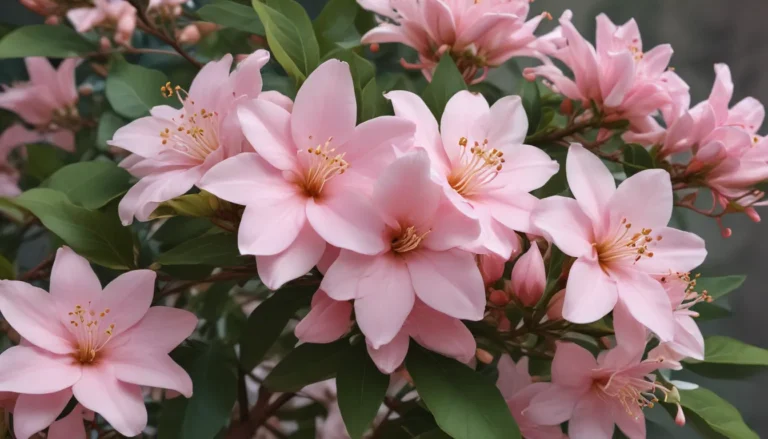The pictures we use in our articles might not show exactly what the words say. We choose these pictures to make you interested in reading more. The pictures work together with the words but don’t take their place. The words still tell you the important facts.
Fireweed, also known as Epilobium angustifolium, is a captivating plant that graces meadows, forests, and roadways with its vibrant pink and purple flowers. Beyond its beauty, fireweed holds a myriad of exceptional qualities that make it truly extraordinary. From its resilience in the face of natural disasters to its edible and medicinal properties, fireweed is a plant that deserves our admiration. Join us on a journey to uncover nine fascinating facts about fireweed that will leave you in awe of nature's wonders.
The Beauty of Fireweed
Fireweed, scientifically known as Epilobium angustifolium, is a striking wildflower native to North America, Europe, and Asia. Its vibrant pink to purple flowers create a breathtaking display, especially when it blankets vast landscapes or lines roadsides with its colorful blooms.
A Symbol of Rejuvenation
One of fireweed's most extraordinary traits is its ability to thrive in disturbed areas. Often the first plant to emerge after wildfires or logging activities, fireweed symbolizes rejuvenation and new growth. Its rapid colonization and resilience earned it the name "fireweed," highlighting its role in revitalizing ecosystems.
Culinary and Medicinal Uses
Not only visually appealing, fireweed offers culinary and medicinal benefits. The young leaves can be cooked and eaten as a nutritious vegetable, akin to spinach or kale. In traditional medicine, fireweed has been used to address digestive concerns and skin ailments, showcasing its versatility and healing properties.
A Haven for Pollinators
Fireweed serves as a vital source of nectar for bees and pollinators, contributing to pollination and honey production. The abundant nectar of fireweed produces sought-after honey with a distinctive floral taste and light color, making it a prized commodity.
Mesmerizing Blooming Pattern
Fireweed's flowers bloom in a specific sequence, starting from the bottom and progressing upward along the stalk. This sequential blooming creates a captivating gradient of colors, making fireweed a visually enchanting plant that evolves through its flowering cycle.
Extended Blooming Season
Unlike many flowers with short blooming periods, fireweed boasts a long-lasting season from late spring to early fall, depending on the region. Its enduring display of vibrant colors provides a valuable food source for pollinators late into the growing season.
Resilience and Adaptability
Fireweed has developed unique adaptations to thrive in diverse environments. It can grow in nutrient-poor soils and withstand high levels of heavy metals, showcasing its resilience. Its ability to thrive in different climate zones highlights its adaptability as a species.
Wind-Dispersed Seeds
The seeds of fireweed are dispersed by the wind, aided by small tufted hairs that catch the breeze and transport the seeds to new locations for germination. This effective dispersal mechanism allows fireweed to spread and establish itself in various habitats, contributing to its widespread distribution.
Cultural Significance
Fireweed holds cultural significance for many indigenous communities, featured in ceremonies and revered as a symbol of resilience and healing. Its incorporation into arts and crafts underscores its significance as a cultural emblem, representing the plant's importance beyond its physical attributes.
Conclusion: Celebrating the Marvels of Fireweed
In conclusion, fireweed stands out as an extraordinary plant with a wealth of captivating traits. From its vibrant blossoms to its culinary and medicinal uses, fireweed captures the attention of botanists and nature enthusiasts alike. Its role in ecological succession and resilience in harsh environments highlight its significance in the natural world. Whether admiring its beauty, harnessing its healing properties, or appreciating its ecological contributions, fireweed is a remarkable plant deserving of celebration.
FAQs: Unveiling More Insights About Fireweed
Q: What is fireweed?
A: Fireweed (Epilobium angustifolium) is a perennial herbaceous plant found in temperate regions, known for its tall stalks, vibrant pink flowers, and feathery seeds.
Q: How does fireweed get its name?
A: Fireweed earned its name for its rapid colonization of burned areas after wildfires, often being among the first plants to reappear in those locations.
Q: Is fireweed edible?
A: Yes, fireweed is edible, with various parts of the plant used in culinary applications such as salads, teas, and jellies, offering a nutritional boost similar to spinach or asparagus.
Q: Are there medicinal uses for fireweed?
A: Yes, fireweed has a history of medicinal use, with its leaves and flowers brewed into a tea believed to provide relief for digestive issues, sore throats, and inflammation.
Q: Can fireweed be grown in a garden?
A: Absolutely! Fireweed thrives in garden settings with full sun to partial shade and well-drained soil, attracting pollinators like bees and butterflies while adding a burst of color.
Q: How tall does fireweed grow?
A: Depending on conditions, fireweed can reach heights of up to 6 feet (1.8 meters), showcasing its tall stalks adorned with beautiful pink flowers.
Q: Is fireweed invasive?
A: While fireweed can spread quickly in disturbed areas, it is not typically considered invasive, playing a crucial role in ecological succession and ecosystem restoration.
Q: Can fireweed be used for dyeing fabric?
A: Yes, the flowers of fireweed produce a vibrant pinkish-purple color that can be extracted for natural dyeing purposes on fabrics, yarns, and other materials.
Q: Are there other uses for fireweed?
A: Throughout history, fireweed has been used for food, medicine, and crafting purposes by various indigenous tribes, showcasing its versatility beyond aesthetics.
Weaving Stories of Nature’s Splendor
Fireweed's extraordinary allure captivates nature enthusiasts and botanists alike, offering a glimpse into the wonders of the natural world. If the marvels of fireweed have piqued your interest, consider delving into other captivating subjects. Explore the unique adaptations and ecological significance of native plants like the compass plant. Immerse yourself in the intricate web of relationships within ecology, showcasing the delicate balance between organisms and their environment. Lastly, uncover the diverse array of wildflowers, each with its own tale of fascinating characteristics waiting to be discovered.
Engaging with Trustworthy Content
Our dedication to delivering engaging and reliable content lies at the core of our mission. Each fact shared on our platform comes from contributors like you, offering a wealth of diverse insights and information. To ensure the highest standards of accuracy and credibility, our meticulous editors review each submission carefully. Rest assured in our commitment to quality and authenticity as you explore and learn alongside us.
In conclusion, fireweed is a splendid plant that embodies resilience, beauty, and cultural significance, making it a true gem in the natural world. Embrace the enchanting world of fireweed and embark on a journey of exploration and discovery amidst nature's wonders.






